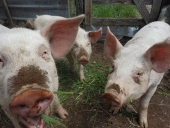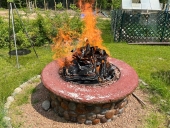Hey. Thanks for the introduction to a new variety to me. The Sakurajima radishes definitely seem worth growing, perhaps more so than the daikon we currently have.
I looked them up and found that they are named after the volcanic area they are from. The soil type is apparently mostly pumice and volcanic ash. I found this which has info on the area as well as some about the radishes.
https://www.env.go.jp/park/kirishima/Phenology%20Calendar%2C%20Sakurajima%20%20%28English%29%20.pdf
In the link it says, "The soil is similar to a wasteland containing pumice. The moderately lean, well-drained earth is excellent for growing radishes as it is easy to control nutrients and water content."
I'm not sure about the specific mineral contents of the volcanic ash, (which may or may not play a significant role in the really large sized radishes,) but it seems somewhat mechanically similar to sand. I imagine, again mechanically bio-char may act in a similar way to the pumice.
If I were to try and replicate the conditions in japan, with what I have on hand, I would use char that has been soaked in compost tea, mixed with sand in a deep bed. I would keep them watered as needed and might include some sea-salt every once in a while.
This is pretty much what I already do but I also add as much organic matter as I can so that I don't have to water/feed as regularly. Our radishes can get to a decent size, (~20" long, 2 1/2" thick at top,) if sown at the right time, mid-late summer, but they are a long variety. If I find some Sakurajima seeds, I think I'll give them a try and see how they do.









